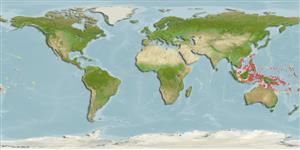Classification / Names
Common names | Synonyms | Catalog of Fishes (gen., sp.) | ITIS | CoL | WoRMS | Cloffa
Actinopterygii (ray-finned fishes) >
Perciformes (Perch-likes) >
Apogonidae (Cardinalfishes) > Apogoninae
Etymology: neotes: Name from Greek meaning youth, referring to the juvenile appearance of this neotenic species (Ref. 11893).
Environment / Climate / Range
Ecology
Marine; reef-associated; depth range 3 - 25 m (Ref. 11893), usually 15 - 20 m (Ref. 48636). Tropical, preferred ?
Western Central Pacific: Philippines (Ref. 48613); Maumere Bay (Indonesia), Palau and Madang, Papua New Guinea; Australia (Ref. 75154) and Solomon Islands (Ref. 90102). Recently reported from Tonga (Ref. 53797).
Size / Weight / Age
Maturity: Lm ? range ? - ? cm
Max length : 2.7 cm SL male/unsexed; (Ref. 11893)
Dorsal
spines
(total): 7;
Dorsal
soft rays
(total): 9;
Anal
spines: 2;
Anal
soft rays: 8;
Vertebrae: 24. This species is distinguished by having D VI-I,9; A II,8; pectoral rays 13; mid-lateral line scales 24; tubed lateral line scales absent; predorsal scales 4; gill rakers 5+16-18, excluding an indistinct rudiment on upper limb; preopercular margin serrate; preopercular ridge smooth; vomer and palatine toothless; body depth 4.2-4.7 in SL; semi-transparent in life with black sub-dermal midlateral stripe and black, pupil-sized spot at the base of the caudal fin (Ref. 11893).
Inhabits lagoons and outer reefs in relatively clear water; usually with soft corals or gorgonian fans (Ref. 11893). Forms small schools (Ref. 48636).
Life cycle and mating behavior
Maturity | Reproduction | Spawning | Eggs | Fecundity | Larvae
Mouthbrooders (Ref. 240). Distinct pairing during courtship and spawning (Ref. 205).
Allen, G.R., R.H. Kuiter and J.E. Randall, 1994. Descriptions of five new species of cardinalfishes (Apogonidae: Apogon) from Maumere Bay, Flores, Indonesia and surrounding regions. Rev. Fr. Aquariol. 21(1-2):27-38. (Ref. 11893)
IUCN Red List Status (Ref. 115185)
CITES (Ref. 94142)
Not Evaluated
Threat to humans
Harmless
Human uses
More information
ReferencesAquacultureAquaculture profileStrainsGeneticsAllele frequenciesHeritabilityDiseasesProcessingMass conversion
Tools
Special reports
Download XML
Internet sources
Estimates of some properties based on models
Phylogenetic diversity index (Ref.
82805): PD
50 = 0.5000 [Uniqueness, from 0.5 = low to 2.0 = high].
Bayesian length-weight: a=0.00646 (0.00275 - 0.01515), b=3.19 (2.99 - 3.39), in cm Total Length, based on LWR estimates for this (Sub)family-body shape (Ref.
93245).
Trophic Level (Ref.
69278): 3.2 ±0.4 se; Based on size and trophs of closest relatives
Resilience (Ref.
69278): High, minimum population doubling time less than 15 months (Preliminary K or Fecundity.).
Vulnerability (Ref.
59153): Low vulnerability (10 of 100) .
